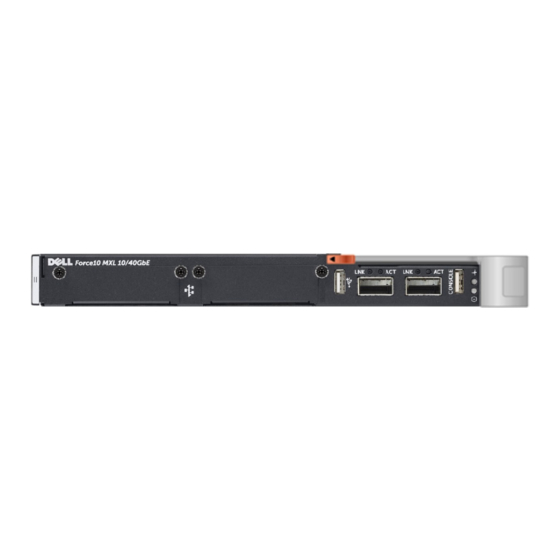Dell Force10 MXL 10 GbE Handbuch "Erste Schritte - Seite 5
Blättern Sie online oder laden Sie pdf Handbuch "Erste Schritte für Schalter Dell Force10 MXL 10 GbE herunter. Dell Force10 MXL 10 GbE 38 Seiten. 10/40gbe blade switches
Auch für Dell Force10 MXL 10 GbE: Handbuch (27 seiten)

Introduction
This document provides basic information about the Dell Force10 MXL
10/40GbE Switch IO Module, including how to install the switch in the Dell
PowerEdge M1000e Enclosure and perform the initial configuration.
For more detailed information about any of the basic installation steps, refer to
the Dell PowerEdge M1000e Enclosure Owner's Manual on the Dell Support
website at http://support.dell.com/manuals.
Product Description
The MXL 10/40GbE Switch is a layer 2/3 blade switch with two fixed 40GbE
ports on the base module and support for two optional plug-in modules. The
switch operates in a PowerEdge M1000e Enclosure, which can support up to
32 servers and six MXL 10/40GbE Switches.
The MXL 10/40GbE Switch runs the Force10 Operating System (FTOS),
providing switching, bridging, and routing functionality for transmitting data,
storage, and server traffic as follows:
•
GbE/10GbE connections through the midplane to up to 32 server ports in
the chassis
•
GbE, 10GbE or 40GbE connections through uplink ports to top-of-rack
(ToR) switches
•
40GbE stacking connections to other MXL 10/40GbE Switches in a
switch stack
In a data center network, the MXL 10/40GbE Switch provides converged
network support and interoperates with Dell and third-party ToR devices.
The switch supports data center bridging (DCB) features, and optimizes
connectivity between servers and storage devices over Fiber Channel over
Ethernet (FCoE) and iSCSI links.
By providing increased 40GbE bandwidth for device interconnection in a
shared network storage environment, with the possibility of splitting 40GbE
QSFP+ uplinks into 10GbE SFP+ connections, the MXL 10/40GbE Switch
is perfectly positioned to help transition a data center with multiple speed
requirements.
5
Introduction
